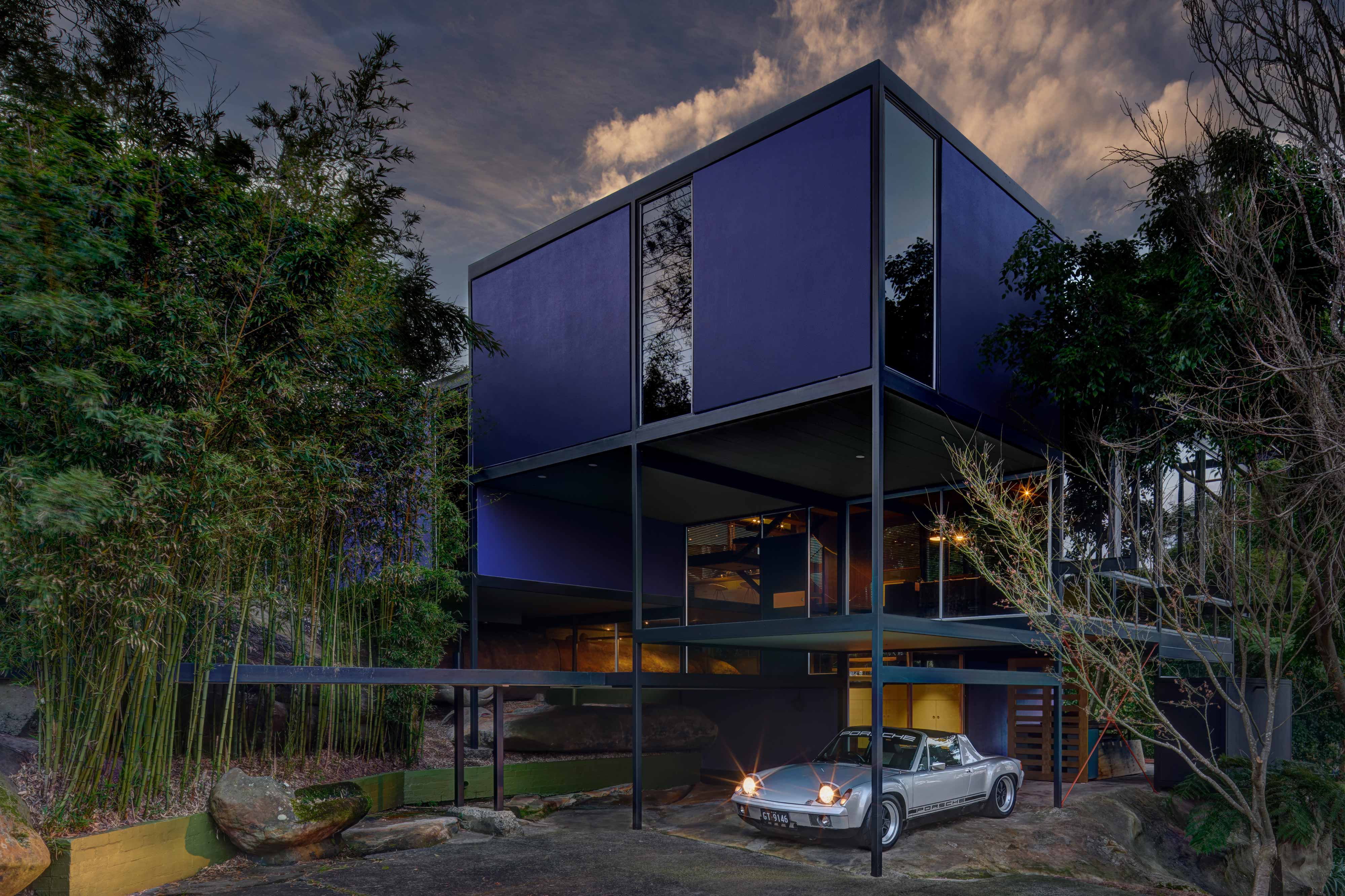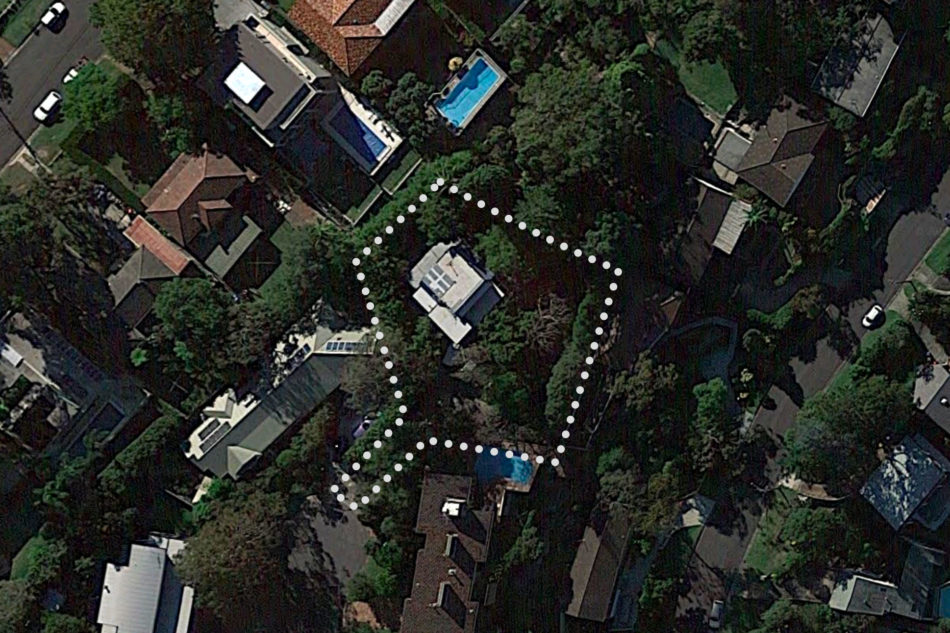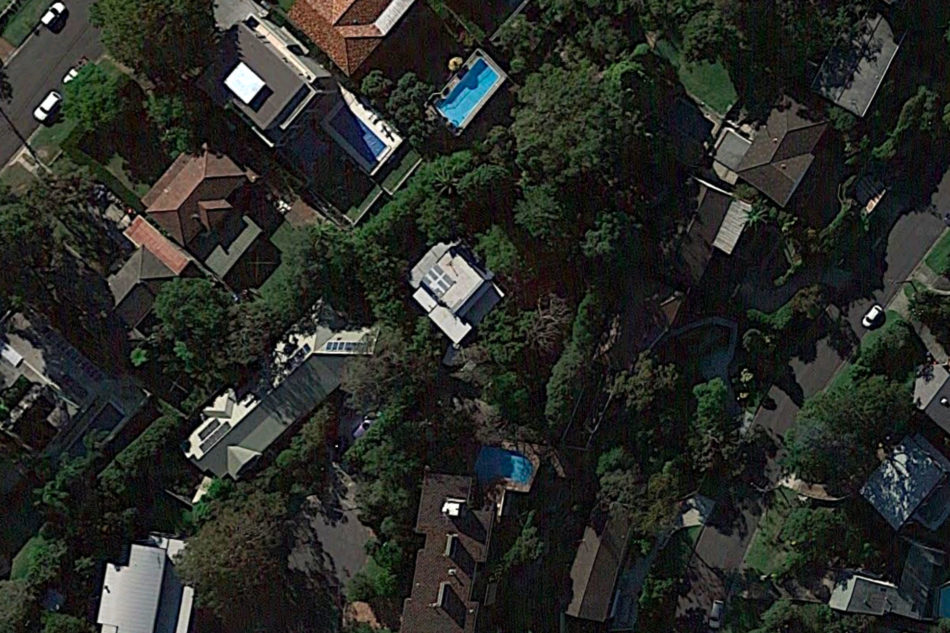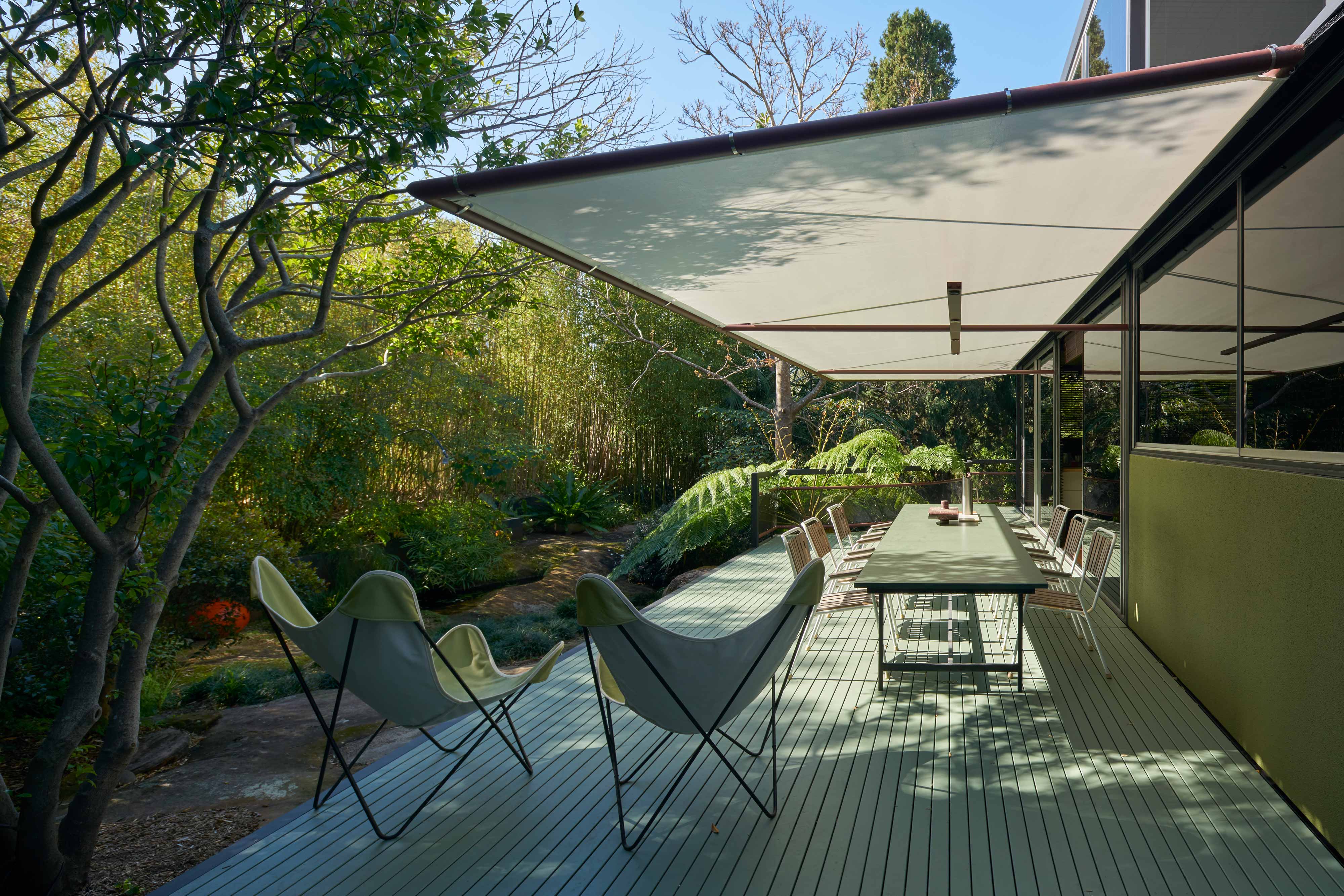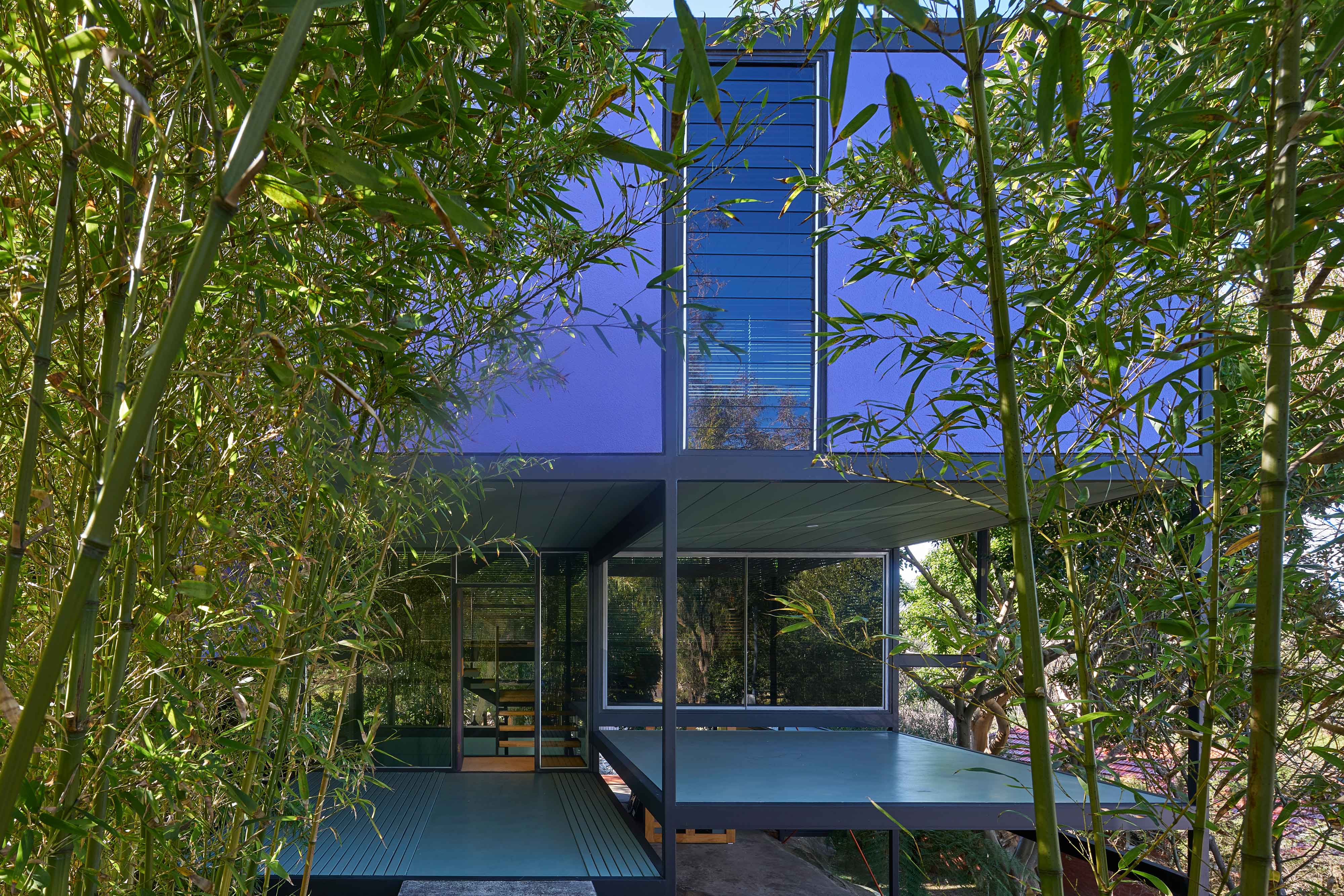Fombertaux House
Architect
Oser Fombertaux & Associates
Designed and Built
1964 – 1966
Design Architect
Jean Fombertaux
Engineer
Taylor Thomson Whitting
Builder
Jean Fombertaux
Restoration & Finishing
Andre Fombertaux
Location
23 Karoo Avenue, East Lindfield
Specifications
4 Bedroom, 2 Bath, 4 Car
Further Rooms
6 Living Spaces, Office & Studio/Guest
Photography
© Michael Nicholson
Share
Introduction
Fombertaux House is an exceptional example of architecture’s rarest jewel: an architect’s own home. A place where the designer has been able to express their skills, push boundaries and have complete control in shaping an environment of their own, the architect’s own home provides some of the best examples of architectural achievement.
Located on Sydney’s North Shore, an area bristling with some of the finest mid-century houses in Australia, Fombertaux House at Karoo Avenue, East Lindfield holds its own. Designed in 1964 by French born architect Jean Fombertaux (1920-1975) for his own family, it is one of the earliest examples of an expressed steel frame domestic building. Perched on slender steel columns at the edge of the escarpment, its cubic form is clad in pre-cast concrete panels contrasted with large areas of glazing. Internally, the house reflects Fombertaux’s interest in Asian and particularly Japanese design, with living areas arranged on open platforms that spiral around the central stair.
Lovingly maintained by son Andre Fombertaux, Fombertaux House is a rare example of an important work by a talented designer that has remained intact for more than 50 years.
“A truly exceptional example of Australian mid-century modernism, Fombertaux House is one of a kind. ”
The Design
Architect Jean Fombertaux was well into his career when he purchased the vacant, steeply sloping block of land at the end of Karoo Avenue. Fombertaux used the opportunity of his own house to explore a creative, yet economical grid design of standard construction units within an enclosing steel frame. Originally painted white with expressed black steel frame, when it was first occupied in 1966 the house’s cubic form made a bold statement in its suburban setting.
The experimental house reflects Fombertaux’s interest in modern materials and his unique hybrid of European and Asian architectural influences. The central concept of the design is a grid of 16 steel columns intersected by concrete floor plates that spiral incrementally upward around the central stair. Fombertaux adopted a restrained palette of materials that includes exposed steel, pre-cast concrete panels and glass. The structure is simplified to its most essential elements and left visible so that one cannot experience the house without appreciating Fombertaux’s skilful framing and bracing of the feather-light structure.
There is no lack of drama in the Fombertaux House. Its fine steel columns are set deep into the exposed bedrock and the contrast between the solidity of the rock and the lightness of the steel is expressed in a number of places in the interior. The house creatively adapts to its steep site, sitting high above it and providing entry to its first floor living spaces via a bridge entry suspended between the house’s steel frame and a large exposed boulder.
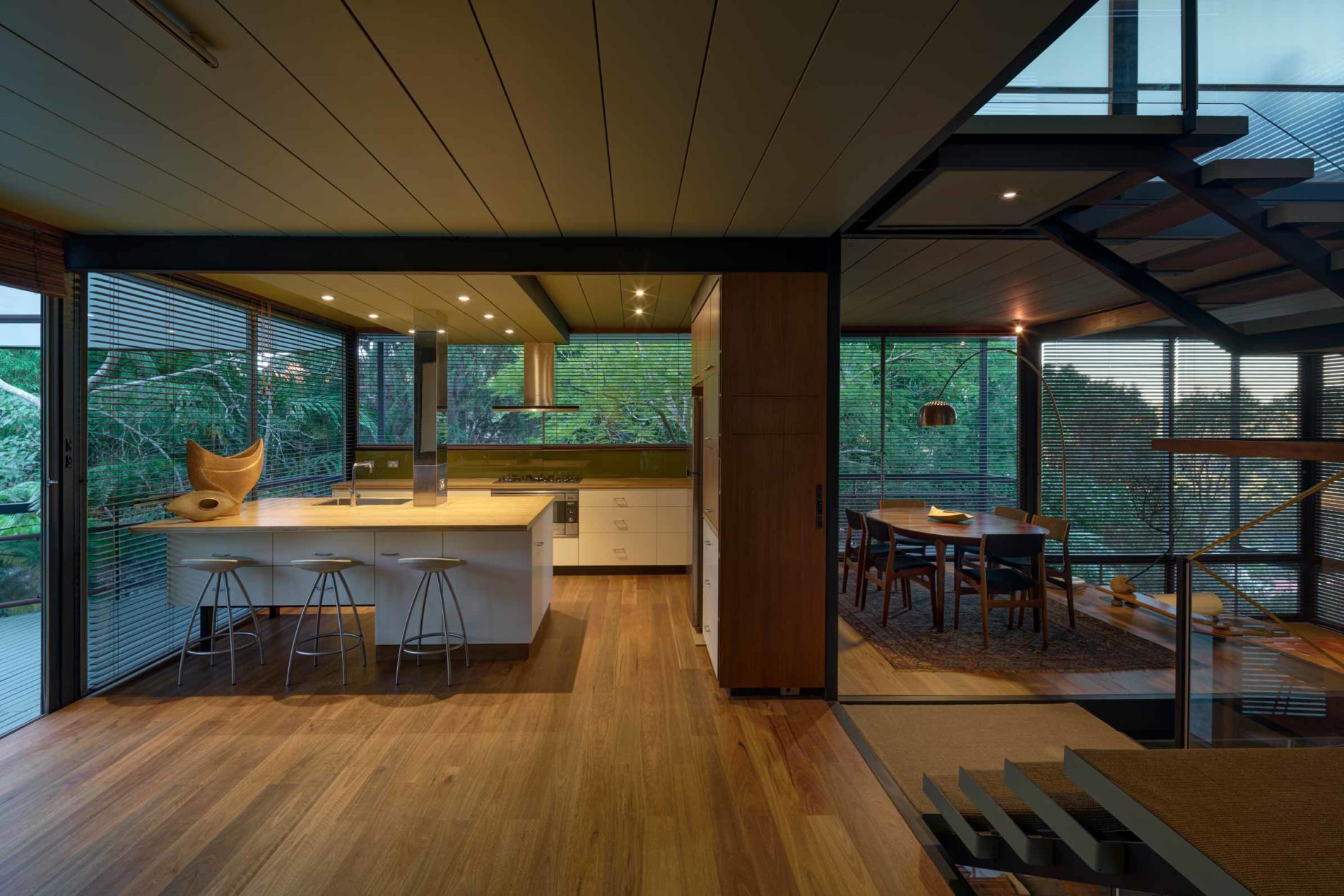
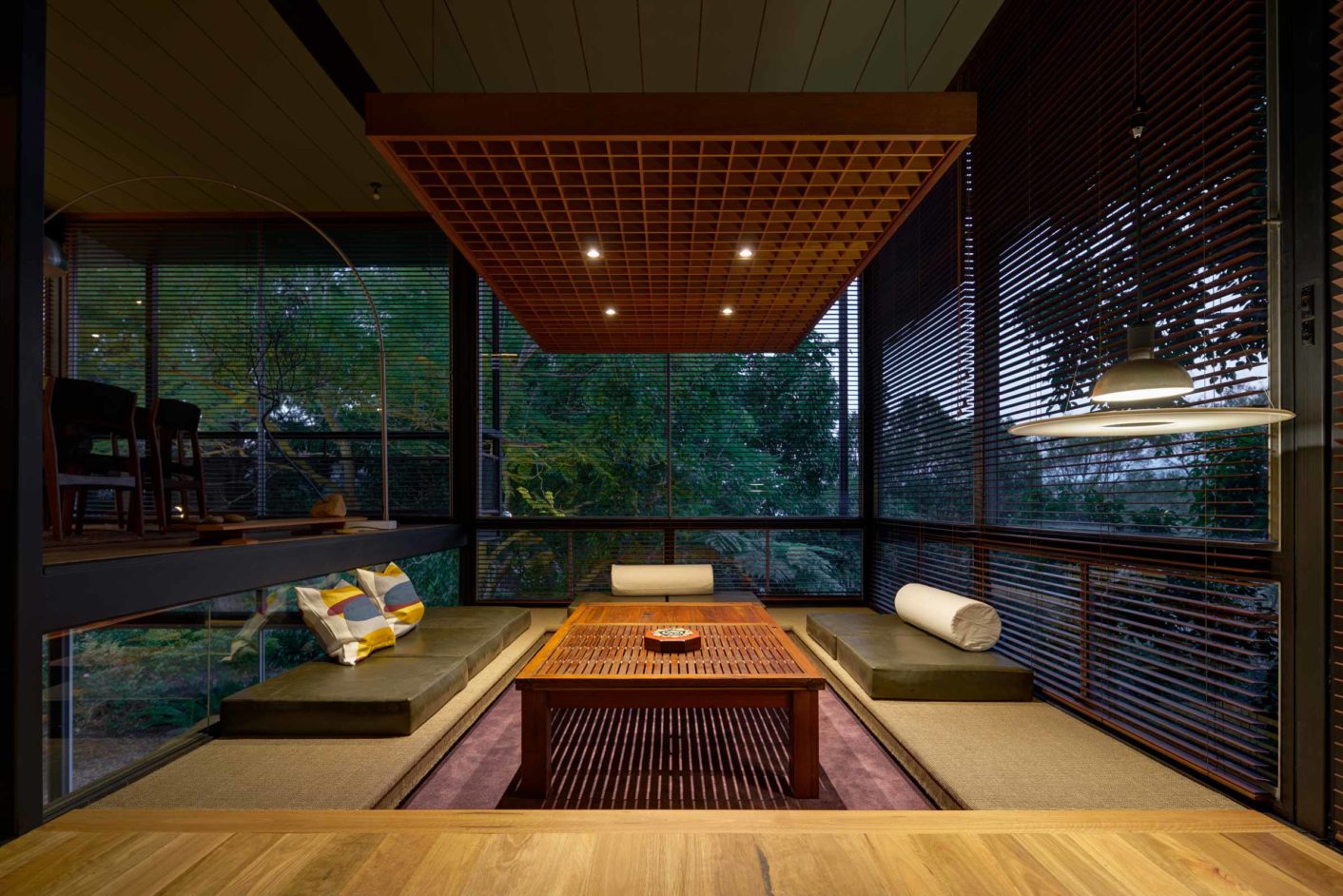
The lower levels of the house are dedicated to working spaces (carport, office, studio/guest and laundry) with the living areas above and rising to the sleeping areas secluded at the top of the house. The result is a compact house with few room divisions allowing its living spaces to be visually linked across levels. The sunken lounge area further plays with the house’s minimalist geometry and hints at Fombertaux’s interest in Japanese spatial planning.
The central stair provides a vertical link to the internal spaces that fan out from it. Largely glazed it also forms a light well, brining an internal openness to a house already basking in wide expanses of external glazing. Privacy from the street is provided by pre-cast concrete panels set into the steel frame on the western elevation. The rear elevations have much greater openness with glazed panels the full width of the frame located across most of the northern and eastern sides of the house.
As a result of the steep site the living areas combine level garden access and elevated leafy views. The kitchen, recently expanded by Andre Fombertaux links to a deck set within the higher areas of the garden. An enclosed family room and bathroom link to the otherwise open lounge and dining areas of the entry level. The sunken lounge area, set below the dining level, provides expansive views to the south east and the site’s mature trees.
Within the house’s balance of open and closed spaces the honesty of its structure is always visible. An exhilarating house, its considered spaces provide peaceful contemplation as well as a sense of excitement that one cannot imagine tiring of.
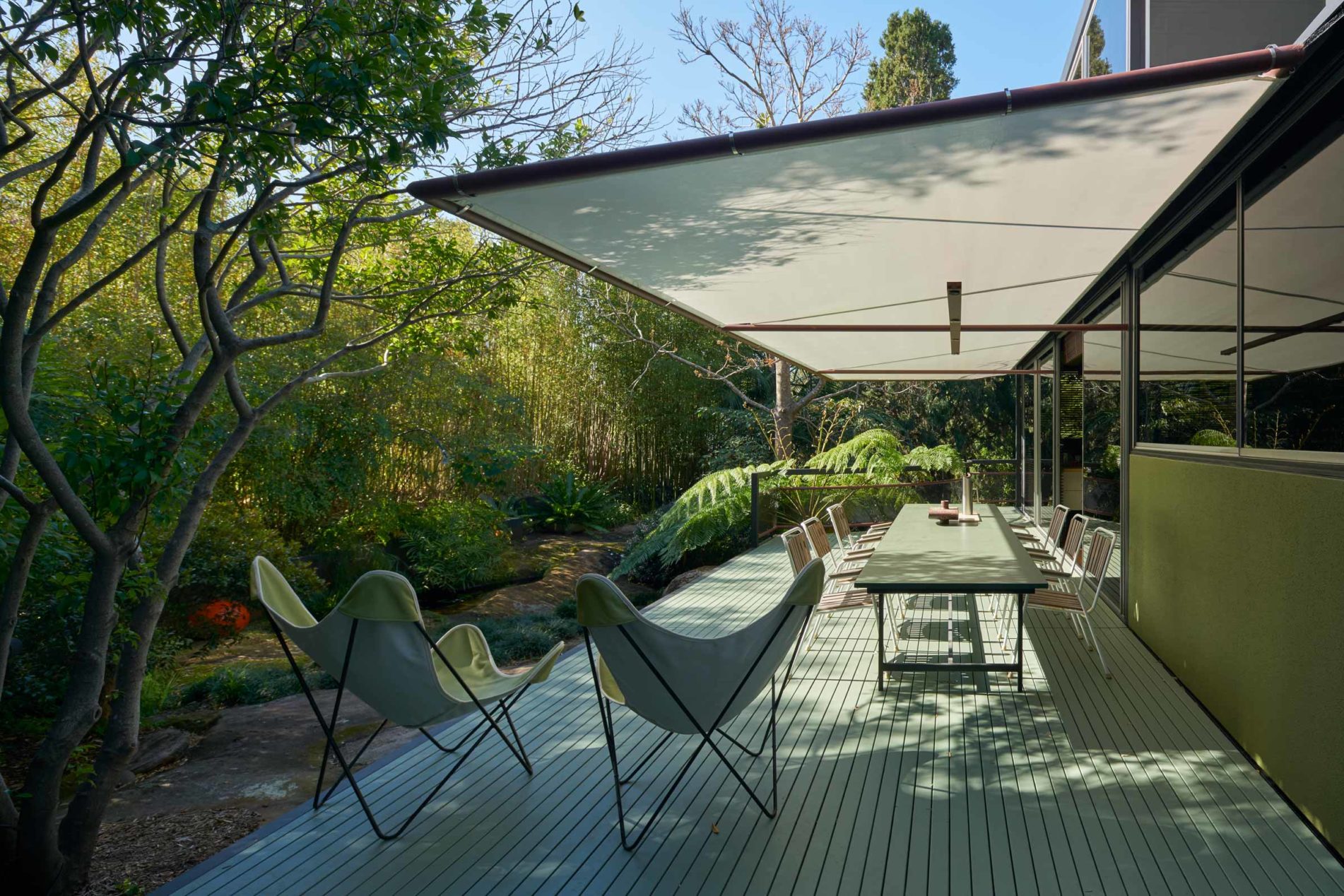
Specifications
Address
23 Karoo Avenue, East Lindfield
Specification
4 Bedroom, 2 Bath, 4 Car
Further rooms:
6 Living Spaces, Office & Studio/Guest
Internal area (approx.)
230 sq m (2,476 sq ft)
Carport area (approx.)
37 sq m (398 sq ft)
External deck areas (approx.)
41 sq m (441 sq ft)
Land area (approx.)
1,252 sq m (13,476 sq ft)
Floor Plan
Download
By Appointment
Modern House Estate Agents
Telephone toll-free: 1300 814 768
Email: viewings@modernhouse.co
Location
It is little wonder East Lindfield was gazetted as a suburb in its own right in 1994, with its tree-lined avenues, shady streets, post-war architecture and elevated position above Middle Harbour, its distinction from Lindfield was justified.
Sitting high on the north eastern end of the escarpment, Karoo Avenue is a cul-de-sac enclave with less than two dozen houses on large blocks set back from the street. The architecture consists of mid 20th century architectural styles with several stand out examples reflecting the era of its development.
Nearby is East Lindfield Village which has a wide variety of specialty and boutique shops set in a true village atmosphere. The expansive shopping precinct and transport hub of Chatswood is just 5 minutes away, with David Jones, Myer, Coles and Woolworths. Also represented are many other major retailers as well as the inclusion of two major cinema complexes and an inexhaustible range of dining experiences.

The home is within walking distance of the local primary schools and has the advantage of being in the catchment zone for Killara High. All of the major private schools on the North Shore from North Sydney to Wahroonga are accessible via the local train station, just a 5 minute drive.
An urban peninsular surrounded on three sides by the vast open spaces of Garigal National Park with vistas of Middle Harbour, Karoo Avenue is also within easy reach of the Ku-ring-gai Chase and the water based attractions of Pittwater. The Northern Beaches are to the east, Dee Why and Curl Curl being only a 20 minute drive.
Originally developed post war, much later than its larger sibling, East Lindfield is 13 kilometres north of the Sydney CBD and historically enjoys good transport links. By car the Pacific Highway is one of the main commuter links to the city and a regular train service runs directly to the CBD, taking 20 minutes to Wynyard Station. Lindfield station is on the North Shore line of the City Rail Network, with trains leaving for the city every 5 to 10 minutes.
It is little wonder East Lindfield is one of the most sought-after suburbs on the lower North Shore offering superb access to all the amenities required for today’s lifestyle.

Architect
Jean Georges Henri Fombertaux (1920-1975), born in Nice, France, brought a unique mix of European and Asian architectural influences to his work. His father’s job in the French Foreign Service meant the family had lived in Switzerland, South East Asia and China, as well as their native France, before the 16-year-old Jean and his family arrived in Sydney in 1936.
Fombertaux studied architecture at the Sydney Technical College, graduating in 1947. He then worked in the modernist architectural practice of Lipson and Kaad, where he is recorded as the project architect for the firm’s Tuberculosis Hospital, Turramurra. In 1950 the young architect travelled, working in New Caledonia, South Africa and Paris; reportedly including a job offer from Le Corbusier. Returning to Australia, in 1956 Fombertaux joined with experienced Austrian émigré architect Hans Peter Oser with the pair forming the successful partnership of HP Oser Fombertaux & Associates in 1960.
HP Oser Fombertaux & Associates developed a high profile commercial practice completing numerous strongly internationalist style buildings in Sydney during the 1960s. Fombertaux, a talented designer, played a key role in their work. The firm’s remaining and still highly regarded projects include the Toohey’s Limited Administration Building in Mary Street, Surry Hills (1960), the William Bland Centre, Macquarie Street, Sydney (1960) and a complex of bachelor flats for young executives, steeped down Bayswater Road, Kings Cross (1963).
The Institute of Architects’ 1971 survey 444 Sydney buildings includes three of the firm’s projects: the 1966 Glenmore Apartments (1966), Glenmore Road, Paddington; the Helena Rubenstein factory (1966), Ermington; and the interior of the BOAC Travel Centre, Castlereagh Street (1963). One of their domestic designs, the Santina was produced as a project home by Civic Construction Company in the 1960s. Shortly after the firm completed the 215-unit Roseberry public housing scheme (1966), Oser died unexpectedly, aged 57.
Fombertaux took on Kevin Rice and David Hanly as partners, forming Fombertaux Rice Hanly which remained prominent, employing 20 architects in their Argyle Street, Sydney offices. Fombertaux died suddenly aged only 56, leaving a prominent firm and a considerable body of architectural work.
Photo: Jean Fombertaux
Photographer and date unknown
Courtesy The family of Jean Fombertaux
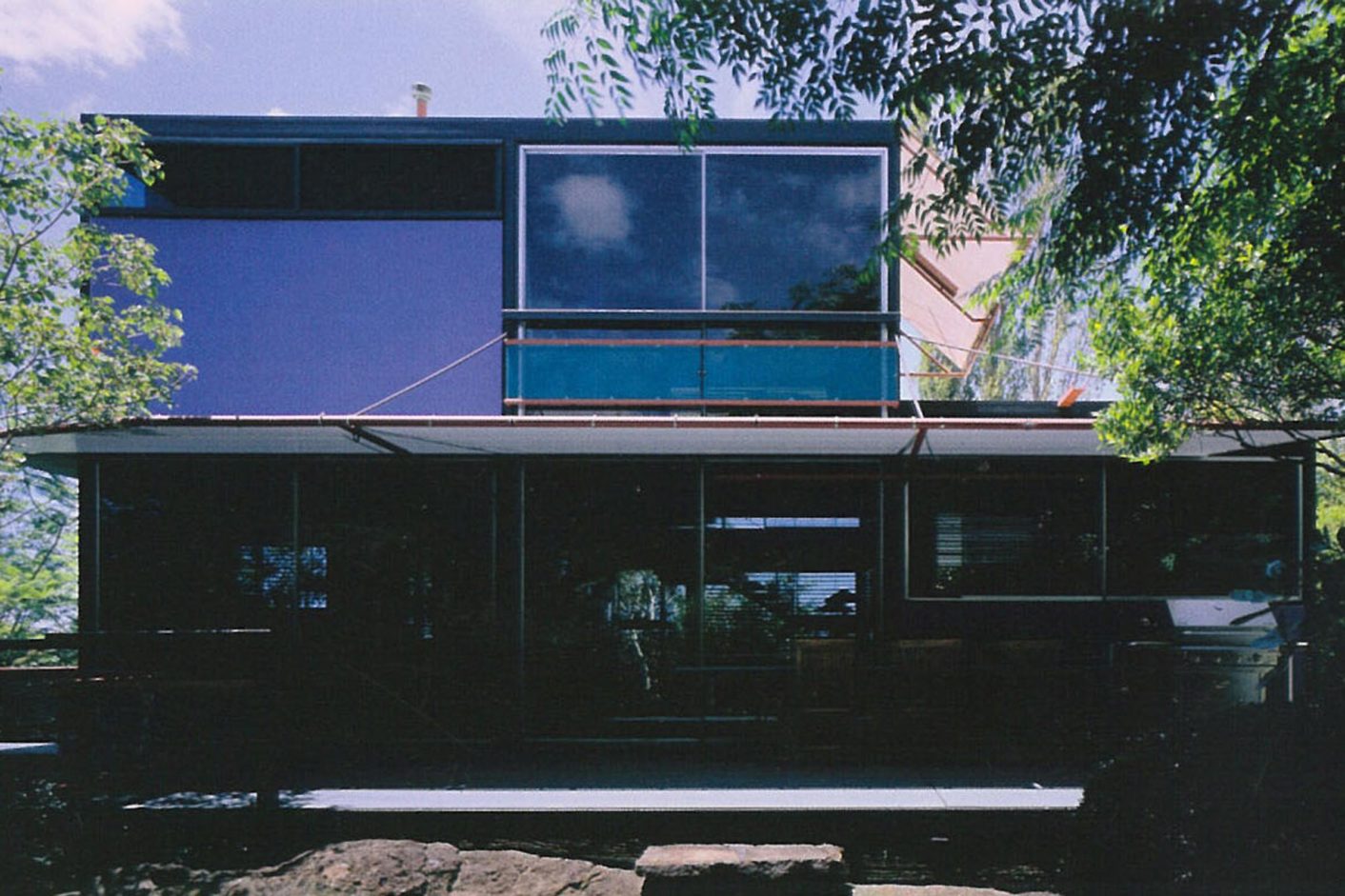
History
Fombertaux House is a rare example of the architect’s domestic work. His commercial and high-rise projects undertaken in the firm HP Oser Fombertaux & Associates are much better known.
Fombertaux’s son Andre, a highly skilled cabinet maker and builder, has been long-term resident and custodian of the house. Andre has taken on the maintenance of the house with an approach that can only be described as a tribute to his father. On the lower levels Andre has expanded the laundry area into an office while maintaining the feature raw rock wall. Circa 1985, an additional bedroom was added enclosing a roof space on the top level, see fig. 20 of the floor plan. Most recently, the kitchen has been expanded with the original timber wall dividing kitchen and dining spaces modified to allow for further storage. While the compact house has been expanded and its facilities brought up-to-date with an emphasis on fine detailing, its essence, and Fombertaux’s design intent, remain perfectly clear.
Now nestled within dense greenery, the once startling cubic house at the end of Karoo Avenue sits comfortably within its setting, restored to a level of perfection rarely seen, and now ready for a new custodian.
Publications
Monument, Architecture & Design, Issue 78, Classic Houses Vol 2, 2007
Sydney Architecture - Paul McGillick, Patrick Bingham-Hall, 2005
A Guide to Sydney Architecture - Graham Jahn, 1997
Architecture in Steel: the Australian context - Alan Ogg, 1987
Design in Steel, BHP Journal, 1975
The Encyclopedia of Australian Architecture - Philip Goad & Julie Willis, 2012
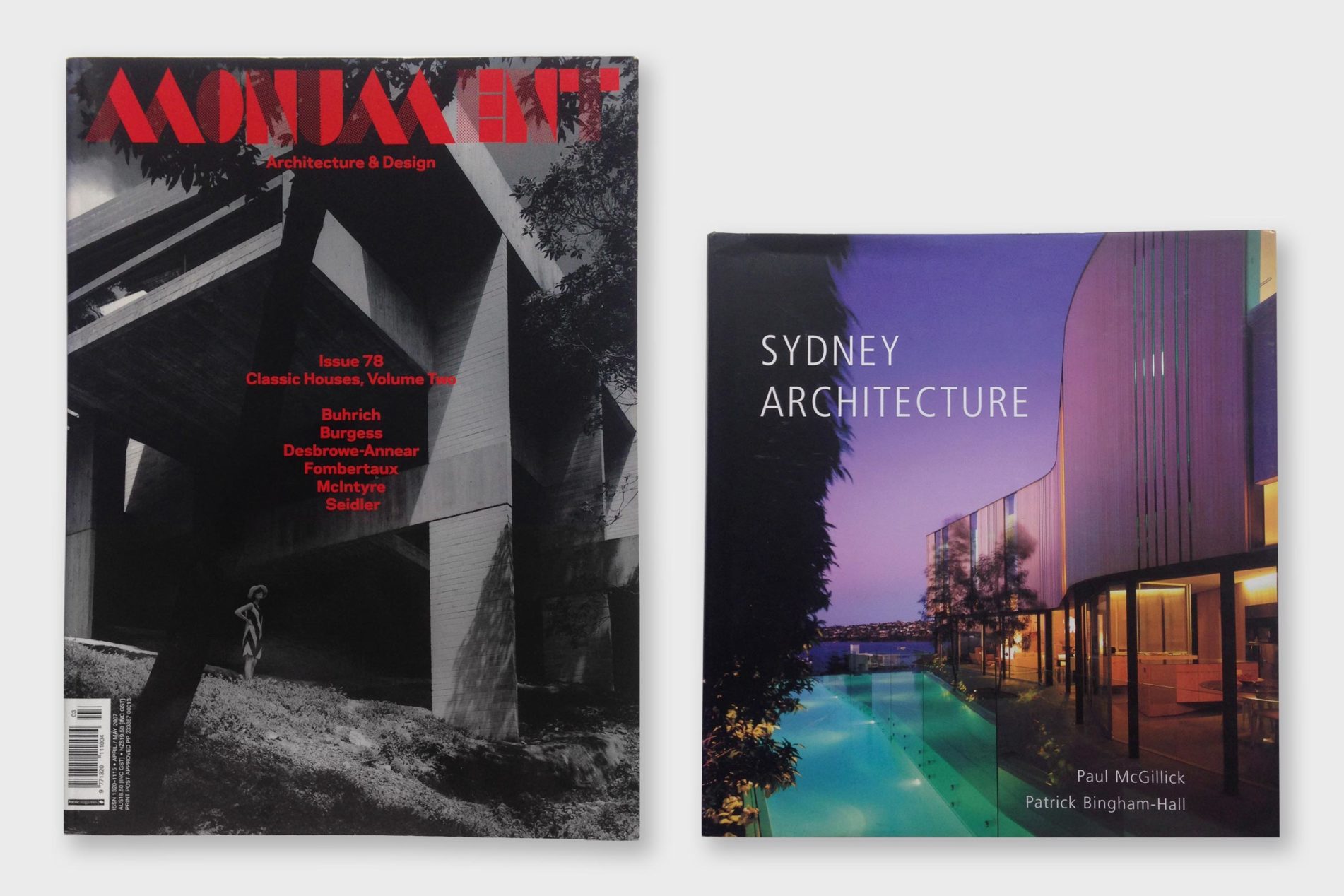
By Appointment
Modern House Estate Agents
Telephone toll-free: 1300 814 768
Email: viewings@modernhouse.co


